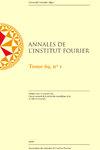Minimal time issues for the observability of Grushin-type equations
IF 0.7
4区 数学
Q2 MATHEMATICS
引用次数: 28
Abstract
The goal of this article is to provide several sharp results on the minimal time required for observability of several Grushin-type equations. Namely, it is by now well-known that Grushin-type equations are degenerate parabolic equations for which some geometric conditions are needed to get observability properties, contrarily to the usual parabolic equations. Our results concern the Grushin operator $\partial_t - \Delta_{x} - |x|^2 \Delta_{y}$ observed from the whole boundary in the multi-dimensional setting (meaning that $x \in \Omega_x$, where $\Omega_x$ is a subset of $\mathbb{R}^{d_x}$ with $d_x \geq 1$, $y \in \Omega_y$, where $\Omega_y$ is a subset of $\mathbb{R}^{d_y}$ with $d_y \geq 1$, and the observation is done on $\Gamma = \partial \Omega_x \times \Omega_y$), from one lateral boundary in the one-dimensional setting (i.e. $d_x = 1$), including some generalized version of the form $\partial_t - \partial_{x}^2 - (q(x))^2 \partial_{y}^2$ for suitable functions $q$, and the Heisenberg operator $\partial_t - \partial_{x}^2 -(x \partial_z + \partial_y)^2$ observed from one lateral boundary. In all these cases, our approach strongly relies on the analysis of the family of equations obtained by using the Fourier expansion of the equations in the $y$ (or $(y,z)$) variables, and in particular the asymptotic of the cost of observability in the Fourier parameters. Combining these estimates with results on the rate of dissipation of each of these equations, we obtain observability estimates in suitably large times. We then show that the times we obtain to get observability are optimal in several cases using Agmon type estimates.grushin型方程可观测性的最小时间问题
本文的目标是提供几个关于几个grushin型方程的可观测性所需的最小时间的尖锐结果。也就是说,现在众所周知,格鲁辛型方程是退化抛物型方程,与通常的抛物型方程相反,它需要一些几何条件才能获得可观测性。我们的结果与Grushin算子有关 $\partial_t - \Delta_{x} - |x|^2 \Delta_{y}$ 在多维设置下从整个边界观察(即 $x \in \Omega_x$,其中 $\Omega_x$ 是的子集 $\mathbb{R}^{d_x}$ 有 $d_x \geq 1$, $y \in \Omega_y$,其中 $\Omega_y$ 是的子集 $\mathbb{R}^{d_y}$ 有 $d_y \geq 1$,观察就完成了 $\Gamma = \partial \Omega_x \times \Omega_y$),从一维环境中的一个侧向边界(即 $d_x = 1$),包括该形式的一般化版本 $\partial_t - \partial_{x}^2 - (q(x))^2 \partial_{y}^2$ 对于合适的函数 $q$和海森堡算子 $\partial_t - \partial_{x}^2 -(x \partial_z + \partial_y)^2$ 从一侧边界观察。在所有这些情况下,我们的方法强烈依赖于对方程族的分析,这些方程族是用方程的傅里叶展开得到的 $y$ (或 $(y,z)$)变量,特别是傅里叶参数中可观察性代价的渐近性。将这些估计与这些方程的耗散率的结果结合起来,我们得到了适当大时间内的可观测性估计。然后,我们证明了在使用Agmon类型估计的几种情况下,获得可观察性所需的时间是最优的。
本文章由计算机程序翻译,如有差异,请以英文原文为准。
求助全文
约1分钟内获得全文
求助全文
来源期刊
CiteScore
1.70
自引率
0.00%
发文量
92
审稿时长
1 months
期刊介绍:
The Annales de l’Institut Fourier aim at publishing original papers of a high level in all fields of mathematics, either in English or in French.
The Editorial Board encourages submission of articles containing an original and important result, or presenting a new proof of a central result in a domain of mathematics. Also, the Annales de l’Institut Fourier being a general purpose journal, highly specialized articles can only be accepted if their exposition makes them accessible to a larger audience.

 求助内容:
求助内容: 应助结果提醒方式:
应助结果提醒方式:


